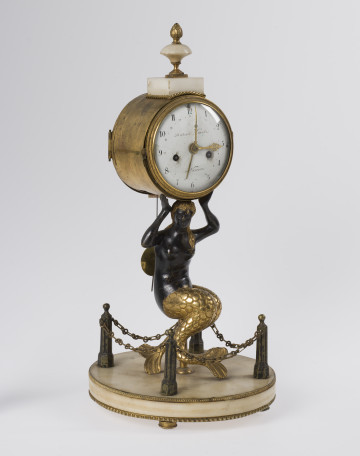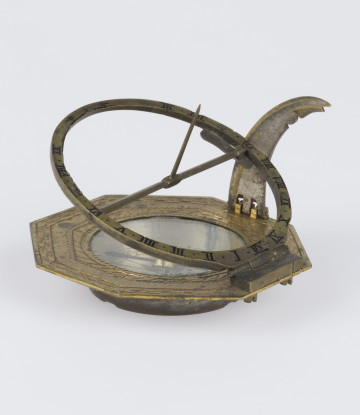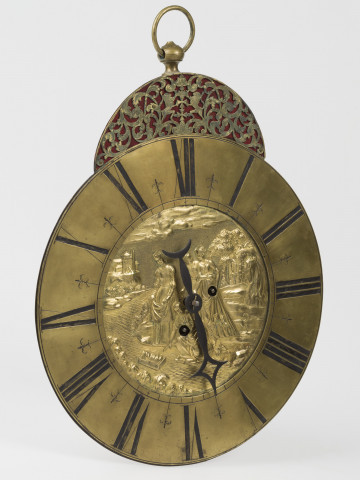
Mantel clock
Museum of King Jan III's Palace at Wilanów
Part of the collection: European enamelworks
A round plaque with the image of a horseback knight filling its surface almost entirely, covered fully with enamel with en grisaille decoration against a black background with gildings. The representation is enlivened by colour accents of details in a blue, green, ochre and violet tone. A standing grey horse turned right is bestridden by a bearded man dressed in a long coat with a shield thrown over his left arm and holding reins in his hands. A broad buttoned saddlebag hangs at his right side. The horse is dressed in decorative harness with feathers over its head and covered with a decorative horsecloth in a rich Renaissance pattern with blue fringes. Around the brink of the upper edge, an inscription written in gold letters (partly crumbled) is visible on both sides: ‘Josue Rex’.
Joshua and his story are described in the Book of Joshua in the Old Testament. His name, given by Moses, meant: ‘Jehovah is redemption’. He is regarded as a symbol of faithfulness and steadfastness. He was the biblical successor of Moses and led the Israelites to the Promised Land. Then he divided it between Jacob’s twelve sons, giving rise to Israelite generations. Joshua lived 110 years.
The plaque belongs to a cycle of decorative representations with images of ‘The Nine Worthies’. The Wilanów collection includes also the second plaque from this cycle with a representation of Hector. The theme of brave men, known also as ‘Heroes of the World’ or ‘Nine Valiants’, was particularly popular in the late Middle Ages due to Les Voeux du paon (ca. 1310) – a poem by Jacques de Longuyon. It extolled such virtues as courage, faithfulness and honour. They were personified by ancient (Hector, Alexander the Great, Julius Caesar), Old Testament (Joshua, David, Judas Maccabeus) and Christian heroes (King Arthur, Charlemagne, Godfrey of Bouillon).
On the basis of scarce original information, we can suppose that the collection of Limoges enamels in Wilanów was presumably created by Aleksander Potocki and expanded by his son August.
The plaque was shown to the Warsaw audience during An Exhibition of Antique and Art Objects in the palace of Count August Potocki and his wife at Krakowskie Przedmieście 32 (today the Museum of the University of Warsaw) in 1856. It is described in the catalogue of this exhibition along with the plaque Wil.203 under item 804.
Joanna Paprocka-Gajek
Dimensions
entire object: height: 22,0 cm, width: 22,0 cm
Technique
forging,enamel
Material
copper
Owner
Museum of King Jan III's Palace at Wilanów
Identification number
Location / status

Museum of King Jan III's Palace at Wilanów

Museum of King Jan III's Palace at Wilanów

Museum of King Jan III's Palace at Wilanów
DISCOVER this TOPIC
Museum of King Jan III's Palace at Wilanów
DISCOVER this PATH
Educational path